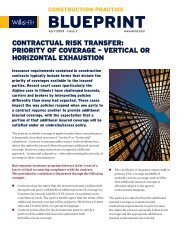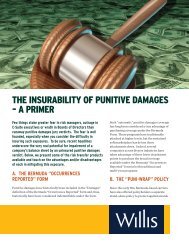spRING 2011 GlobAl MARKETs INTERNATIoNAl - Willis
spRING 2011 GlobAl MARKETs INTERNATIoNAl - Willis
spRING 2011 GlobAl MARKETs INTERNATIoNAl - Willis
You also want an ePaper? Increase the reach of your titles
YUMPU automatically turns print PDFs into web optimized ePapers that Google loves.
Tom: “On that theme, we are seeing increases in Business<br />
Interruption renewal values, which may also be partly explained<br />
by those factors. With this in mind, what is driving the uplift in<br />
M&A activity in the Mining sector?”<br />
Lachy: “Confidence in the sector is returning underpinned by strong<br />
margins due to buoyant demand from emerging markets and years of<br />
under investment in mine exploration and development squeezing supply,<br />
a belief that the Chinese urbanisation and industrialisation story still<br />
holds, and current cash reserves and anticipated cash flows.<br />
Despite this positive outlook, there seems to be no imminent return<br />
to the large scale leveraged mergers and acquisitions experienced<br />
in 2006-2007, with the obvious exception of BHP Billiton’s wholly<br />
debt funded attempt to acquire Potash Corp. This can be explained in<br />
part by the difficulties in executing the large, transformational deals.<br />
These difficulties include the notable increase in resource nationalism<br />
(super profits tax and subsequent MRRT in Australia, for example)<br />
and regulatory oversight, the latter arguably scuppering the proposed<br />
production joint venture of the Rio Tinto and BHP Billiton iron ore<br />
operations in the Pilbara.<br />
There is a renewed focus on organic growth, after many companies<br />
slashed capital spending during the crisis to conserve cash. Most notably<br />
the larger mining groups are seeking to leverage their strong cash flows<br />
and robust balance sheets to invest in value adding growth projects across<br />
their product portfolios. Companies including Xstrata ($6b in <strong>2011</strong>),<br />
Rio Tinto ($11b in <strong>2011</strong>) and Vale ($24b in <strong>2011</strong>) have all announced<br />
significant uplifts in capital spending, in addition to BHP Billiton’s<br />
forecast $15b spend in <strong>2011</strong>. Meanwhile, Anglo American has indicated<br />
iron ore capacity could rise to in excess of 150 million tonnes by 2020.<br />
Regardless of the number of high quality projects a company might have<br />
in its pipeline, they can only deploy a certain level of capital expenditure<br />
on organic projects at any point until, for example, the supply of skilled<br />
human capital or lack of infrastructure becomes an impediment.<br />
Accordingly, M&A will remain a feature of the sector, but on a smaller<br />
scale in the foreseeable future than what we saw at the top of the cycle pre<br />
financial crisis. This is being driven by a number of factors.<br />
Firstly, some mining companies are seeking to diversify into new<br />
commodities. Notable recent examples include BHP Billiton’s bid for<br />
PotashCorp, Xstrata’s controlling stake in Sphere Minerals and option<br />
to acquire 50% plus one share in Zanaga Iron Ore Co, and Vedanta<br />
Resources proposed 51% stake in Cairn Energy’s Indian petroleum assets.<br />
Vale has also announced plans to diversify away from iron ore towards<br />
fertilizers and copper.<br />
Secondly, Steel makers continue in their efforts<br />
to vertically integrate with the acquisition of<br />
projects that supply critical raw materials<br />
like iron ore and coking coal to hedge against<br />
commodity price volatility and to ensure supply.<br />
ArcelorMittal’s pursuit of Baffinland Iron Mines<br />
Corp is a recent example.<br />
Thirdly, some transactions are premised on<br />
increasing resources or accessing infrastructure.<br />
Atlas Iron’s $822m deal with Giralia in<br />
December is an example of both, whereby Atlas<br />
increased its resource base whilst Giralia gained<br />
access to Atlas’ port facilities. There is also a<br />
number of deals focused on the development<br />
of much needed infrastructure, notably in<br />
West Africa, where the Simandou, Tonkolili<br />
and Kalia projects have all attracted Chinese<br />
infrastructure investment.<br />
A recent trend has been consolidation amongst<br />
thermal and coking coal producers. These deals<br />
include Walter Energy’s acquisition of Western<br />
Coal and the recent bids for Drummond Coal’s<br />
Colombian assets. Gold has also experienced<br />
a number of deals that have sought to deliver<br />
critical mass and increased resources.<br />
Finally, there are also divestment activities taking<br />
place, as companies seek to refocus on the core.<br />
Anglo American’s disposals of Tarmac, Callide<br />
coal mine in Queensland and Anglo American Zinc<br />
to Vedanta Resources are all examples.”<br />
<strong>Willis</strong> | Mining Market Review <strong>2011</strong> | 83
















